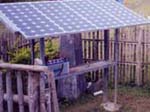GreenMicrofinance supports Microfinance Institutions that are looking to adapt green finance products, as well as develop productive green finance loans for sustainable agriculture, biofuels, biogas, green building, clean energy and/or energy efficiency.
Microfinance and the Environmental Bottom Line
The conventional path of economic development has tied greater prosperity to increased energy consumption, with its corresponding negative environmental impact. This does not have to be the case. Microfinance Institutions (MFIs) can contribute, along with their clients, to solving the crises we face today. Microfinance clients continue to be impacted by global climate change and environmental degradation, but we are also seeing that they can be part of the way forward.
Can microfinance and environmental sustainability go hand-in-hand?
 Some in the industry say it’s not only possible, but essential that microfinance works to prevent environmental damage. It is becoming increasingly clear that the impacts of climate change, pollution, poor waste management, and other environmental problems must be part of the long-term approach to economic development. Otherwise, we risk destroying natural resources that are essential for continued economic growth, as well as endangering public health and safety.
Some in the industry say it’s not only possible, but essential that microfinance works to prevent environmental damage. It is becoming increasingly clear that the impacts of climate change, pollution, poor waste management, and other environmental problems must be part of the long-term approach to economic development. Otherwise, we risk destroying natural resources that are essential for continued economic growth, as well as endangering public health and safety.
Environmental impacts are gaining prominence in the global development agenda and becoming a concern for some national governments and social and environmental investors. Building capacity for green microfinance may in fact be a smart way to prepare for shifting funding priorities and inevitable changes in environmental regulation.
How can microfinance help to address environmental issues?
 Conservation and environmental protection are global issues, and much of the responsibility for addressing them rests in the industrialized world. However, there is growing interest in “green microfinance,” which includes programs that encourage eco-friendly microenterprises and support microfinance clients’ use of renewable energy. The development of carbon-credit aggregation strategies also creates a new opportunity to include smaller enterprises in a green agenda.
Conservation and environmental protection are global issues, and much of the responsibility for addressing them rests in the industrialized world. However, there is growing interest in “green microfinance,” which includes programs that encourage eco-friendly microenterprises and support microfinance clients’ use of renewable energy. The development of carbon-credit aggregation strategies also creates a new opportunity to include smaller enterprises in a green agenda.
Donors and investors can build capacity for green microfinance by providing necessary technical assistance and by supporting environmentally sustainable microfinance projects.
The following are some Eco-Microfinance Initiatives promoted today, such as:
- Green Microenterprises
- Renewable Energy Entrepreneurship
- Carbon Credit Aggregation
Green Microenterprises
 Eco-friendly Microenterprises can provide sustainable sources of income to microfinance clients, including the production of organic fertilizers and biomass charcoal briquettes, clean energy cookstove fabrication, and handicrafts made from sustainably sourced materials. Various industry standards provide guidelines on “sustainable sourcing.”
Eco-friendly Microenterprises can provide sustainable sources of income to microfinance clients, including the production of organic fertilizers and biomass charcoal briquettes, clean energy cookstove fabrication, and handicrafts made from sustainably sourced materials. Various industry standards provide guidelines on “sustainable sourcing.”
MFIs that deal with agricultural clients can seek partners that will help clients adapt to evolving conditions through the adoption of environmentally-friendly farming techniques. Organizations, such as Sustainable Harvest International, help by providing key technical support. Subsidy can also play a positive role as clients shift their approach to a more eco-friendly standard.
Engaging in environmentally sound business practices can:
- Help microentrepreneurs preserve and protect their long-term income
- Protect the health of communities
- Lower overhead for microenterprises
- Enable MFIs to invest in a growing market that meshes well with the agendas of triple-bottom line investors.
Renewable Energy Entrepreneurship
Microfinance clients often use fossil fuels like natural gas and petroleum as sources of energy. These fuel sources contribute to the greenhouse gas problem, the degradation of local ecosystems, and cause health problems. Implementing renewable energy systems, like solar, wind, and biogas can offer great cost savings, as well as health benefits. MFIs offering personal consumption “energy loans” can help microfinance clients leverage these resources for their homes and businesses.
 Renewable energy can also be a source of income for a new class of business – renewable energy microenterprises. Social and environmental entrepreneurs from the industrialized world are helping to create this microentrepreneurship opportunity.
Renewable energy can also be a source of income for a new class of business – renewable energy microenterprises. Social and environmental entrepreneurs from the industrialized world are helping to create this microentrepreneurship opportunity.
MFIs are able to support programs in solar energy, biogas, and improved cookstoves, which include training and capacity building for entrepreneurs who promote the systems, as well as financial products tailored for renewable energy uptake. In the micro-utility model, one entrepreneur will install a solar system and sell power to those in the community who cannot yet afford to invest in their own.
Carbon Credit Aggregation
Carbon credit aggregators work with MFIs that provide renewable energy loans to clients. Each loan can be translated into a small carbon credit. Though these credits are too small to be traded on the multi-million or billion dollar carbon markets created by the Kyoto Protocol, aggregators bundle these credits and then sell them on the voluntary carbon market to net polluters.
Carbon credit aggregation offers:……
- Financial rewards for MFIs that provide energy loans, creating an incentive to continue greening products
- A better standard of living, and more control over energy resources, for clients who switch to renewable sources of energy for their homes or businesses
- Business opportunities for microentrepreneurs who supply renewable energy services or systems
